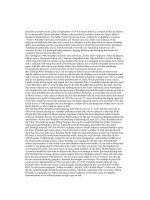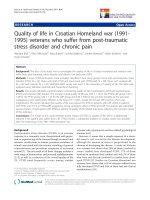The noneffects of class on the gendered division of labor in the home
Bạn đang xem bản rút gọn của tài liệu. Xem và tải ngay bản đầy đủ của tài liệu tại đây (62.45 KB, 13 trang )
8. The noneffects of class on the
gendered division of labor in the
home
The central objective of this chapter is to explore systematically the
empirical relationship between the location of households in the class
structure and gender inequalities in performance of housework. Since the
middle of the 1970s, class analysts interested in gender, particularly
those rooted in the Marxist tradition, have placed domestic labor at the
center of analysis. In a variety of different ways, they have argued that
the linkage between the system of production, analyzed in class terms,
and the domestic division of labor, analyzed in gender terms, was at the
heart of understanding the social processes through which gender
relations were themselves reproduced (or perhaps even generated) in
capitalist societies. Sometimes this argument took a rather reductionist
form, particularly when the performance of unpaid domestic labor by
women in the home was explained by the functional requirements of
capital accumulation.
1
In other cases, the argument was less reductionist,
emphasizing the nature of the class-generated constraints imposed on
strategies of men and women as they negotiated gender relations within
the household rather than the functional ®t between capitalism and
patriarchy. And, in still other analyses, the possibilities of systematic
contradictions between the logics of capitalist class domination and
patriarchal male domination were entertained. In all of these analyses, in
1
The debate over the functional relationship between capitalist exploitation and unpaid
domestic labor by housewives came to be known as the ``domestic labor debate'' in
the 1970s. The essential argument of the class-functionalist position was: (1) unpaid
domestic labor had the effect of lowering the costs of producing labor power; (2) this
increased the rate of capitalist exploitation since capitalists could pay lower wages; (3)
in an indirect way, therefore, capitalists exploited housewives; (4) the basic explanation
for the subordination of women ± or at least, for the reproduction of that subordination
± lay in the ways such domestic production served these functions for capitalism. For a
review of this debate see Molyneux (1979).
146
spite of the differences in theoretical argument, the role of domestic labor
in the linkage between class relations and gender relations was a central
theme.
With this theoretical preoccupation, it might have been expected that
there would have developed a substantial body of research exploring the
empirical relationship between the domestic division of labor and
classes. This has not happened. While there are historical and qualitative
case studies which examine the domestic division of labor and a few of
these attempt to explore the class variations in such patterns, there is
almost no research that tries to map out in a systematic quantitative
manner the relationship between class and the gender division of labor
in the household.
The basic objective of this chapter, then, is to explore empirically the
relationship between class and the gendered domestic division of labor.
More speci®cally, we will examine how the proportionate contribution
by husbands to housework in dual-earner families varies across house-
holds with different class compositions.
8.1 Theoretical expectations
As in chapter 7, because of limitations of available data for spouses'
class and because of limitations in sample size, the empirical investiga-
tions of this chapter will rely on a stripped-down class concept. In this
case we will distinguish three categories: the self-employed (consisting
of employers and petty bourgeois), ``middle class'' (employees who
occupy a managerial or supervisory position within authority structures
and/or are employed in an professional, managerial or technical occu-
pations) and working class (all other employees). This simple three-
category class variable in principle yields nine family-class locations.
Unfortunately, again because of the relatively small sample size, there
were too few people in family-class locations involving the self-
employed to be able to differentiate all ®ve of these categories. As a
result, for families involving self-employment we will not distinguish
between the husband and wife being self-employed. We will thus
analyze family-class composition and housework using the following
seven family-class categories: 1. homogeneous self-employed house-
holds; 2. one spouse self-employed, one middle class; 3. one spouse self-
employed, one working class; 4. homogeneous middle class household;
5. husband middle class, wife working class; 6. husband working class,
wife middle class; 7. homogeneous working-class household. Our em-
147Class and gender in the home
pirical task, then, is to explore how inequality between husbands and
wives in housework varies across the categories of this family-class
composition typology.
While neither Marxism nor Feminism has a well-developed body of
theory about the variability of the domestic division of labor across
households with different class compositions, nevertheless there are
some general expectations within class analysis and feminism that point
towards certain broad hypotheses about this relationship. We will
explore four such hypotheses.
Proletarianization and gender equality
The most well-known discussion of the gender division of labor in
classical Marxism is found in Frederick Engels' study, The Origin of the
Family, Private Property and the State (Engels 1968 [1884]). Engels argued
that male domination within the family was rooted in male control of
private property. The pivot of this linkage was the desire by men to
insure that their property was inherited by their children. To accomplish
this, men needed to control the fertility of women. Given the power and
status they had by virtue of controlling property, men were able to
translate this desire into practice. The broad institutions of male domi-
nation, Engels argued, are built upon this foundation.
On the basis of this reasoning, Engels' argued that male domination
would wither away in the households of propertyless proletarians:
Here, there is a complete absence of all property, for the safeguarding and
inheritance of which monogamy and male domination were established. There-
fore, there is no stimulus whatever here to assert male domination . . . Moreover,
since large-scale industry has transferred the woman from house to the labour
market and the factory, and makes her, often enough, the breadwinner of the
family, the last remnants of male domination in the proletarian home have lost all
foundation. (Engels, 1968 [1884]: 508).
Engels' reasoning leads to two basic hypotheses:
Hypothesis 1. Working-class egalitarianism. The more proletarianized
is a household, the more housework will tend to be equally
divided between husbands and wives. The homogeneous
working-class family, therefore, should have the most egalitarian
distribution of housework.
Hypothesis 2. Petty bourgeois inegalitarianism. Households within
which private ownership of the means of production remains
Class counts148
salient will have a more inegalitarian division of housework. The
homogeneous petty bourgeois household should therefore have
the least egalitarian distribution of housework.
Sexism and class cultures
One of the persistent images in popular culture is the contrast between
the middle-class husband with an apron helping in the kitchen, and the
working-class husband tinkering with the car or drinking in a bar with
his friends. There are many possible mechanisms which might under-
write this contrast. The premium placed on physical toughness and male
solidarity in manual labor may constitute a material basis for an
exaggerated masculine identity in the working class. In line with the
arguments of Melvin Kohn (1969) about the relationship between work
and values, the greater cognitive complexity of middle-class jobs may
encourage a more ¯exible and open set of attitudes towards gender
roles. Regardless of the speci®c mechanism, this image leads to a speci®c
prediction about class and the gender division of labor:
Hypothesis 3. Class cultures. Working-class men will, in general, do
proportionately less housework than middle-class men. Homo-
geneous working-class households should therefore have the
most inegalitarian distribution of housework, while homoge-
neous middle-class households should be the most egalitarian.
Class and power within the family
An important theme in the sociology of gender is the problem of
bargaining power between men and women within households. Parti-
cularly in an era in which gender roles are being challenged, the
division of labor in the household should not be viewed as simply the
result of a script being followed by highly socialized men and women.
Rather, the amount of housework done by husbands should be viewed
as at least in part an outcome of a process of contestation, con¯ict and
bargaining.
The class location of husbands and wives bears on their respective
power in the household in two ways. First, as in any bargaining
situation, the resources people bring to household bargaining affects
their relative power. In these terms, class inequalities between men and
women would be expected to be translated into power differentials
149Class and gender in the home
within the household. The more economically dependent a wife is on her
husband, the weaker will be her bargaining position within the house-
hold and thus the more inegalitarian the gender division of labor is
expected to be. This would imply when wives are in more advantaged
class locations than their husbands, housework should be more equally
divided. Second, quite apart from sheer material resources, status
differentials are likely to play a role in bargaining situation (Coverman
1985). To the extent that wives occupy lower status in the labor force
than their husbands, they are thus also likely to be in a weaker
bargaining position within the household.
Taking these two issues together, leads to the following hypothesis:
Hypothesis 4. Class bargaining power. In households in which the wife
is in a more privileged class location than her husband she will
have greater relative bargaining power and thus her husband is
likely to do more housework. Households with middle-class
wives and working-class husbands are thus likely to be the most
egalitarian.
Autonomy of gender relations
One of the core feminist theses about gender relations in capitalist
society is that they have a certain degree of real autonomy with respect
to other causal processes. On the one hand, this means that gender is
socially constructed rather than a mere expression of biological pro-
cesses. On the other hand, it means that in the social processes within
which this construction takes place, gender is not reducible to any other
social phenomena, particularly class or the economy. While there may be
important causal interactions between class and gender, gender relations
are not mere functions of class or anything else, and in this sense they
have some genuine autonomy.
An implication of relatively strong versions of the gender-autonomy
thesis is that the amount of housework men do will be primarily
determined by the nature of gender relations and gender struggles, not
by such things as class. While this does not mean that class would have
no effects at all, these effects should be fairly muted. This suggests the
following hypothesis:
Hypothesis 5. Gender autonomy. The degree of equality in the gender
division of labor will not vary very much across households with
different class compositions.
Class counts150






![thang nguyen ngoc - 2011 - corporate governance and its impact on the performance of firms in emerging countries - the evidence from vietnam [cg]](https://media.store123doc.com/images/document/2015_01/02/medium_rfd1420194809.jpg)
![thang nguyen ngoc - 2011 - corporate governance and its impact on the performance of firms in emerging countries - the evidence from vietnam [cg]](https://media.store123doc.com/images/document/2015_01/06/medium_tlw1420548434.jpg)

